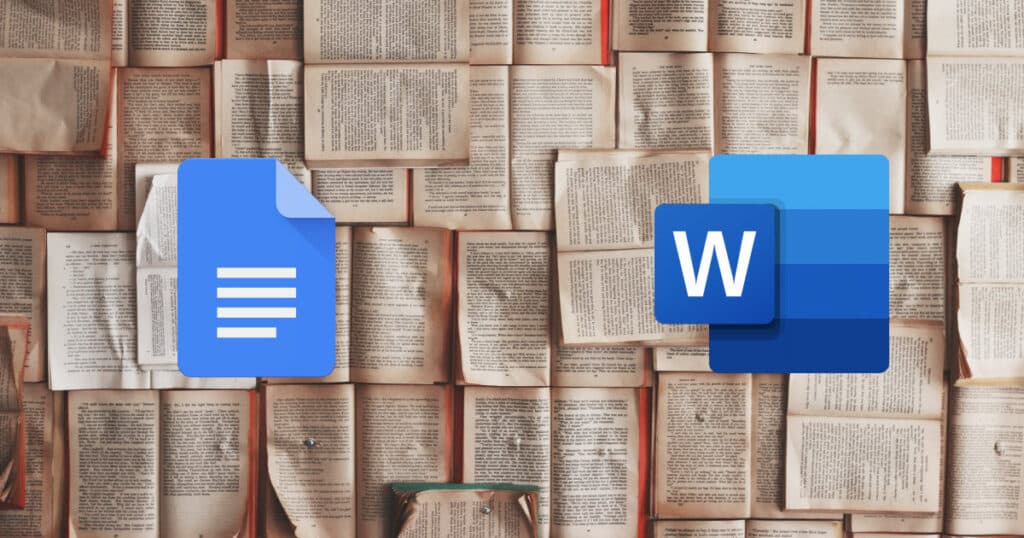It is a question that a lot of people think about when writing reports or essays. Students and creative writers, academic and business writers often use either Google Docs or MS Word as their go-to word processing tool. Both tools have a word count feature, but it helps to know approximately how many words fit on a page. However, words per page depend on several factors such as font size, line spacing, margins, number of paragraphs, and even page size. In this article I’ll help you estimate how many words per page there will be when using either Microsoft Office Suite‘s Word or Google Docs for word processing, with some general average word count numbers based on document line spacing, font, subheading usage, and more.
Let’s get started.
Why Worry About How Many Words there are Per Page?
Word count and page numbers can be useful for writers to understand how they can organize their work, ideas, and manage their time.
If you have an 5-page essay assignment for school, you may want to know how many words that will be. Conversely, if you have to write a 2,500 word essay, you may be wondering how many pages you’ll need to write.

The limitation of words can make it easy to know what to expect from a project or assignment, and can ultimately help guide you when making editing decisions on your project later on.
Nowadays, document word count (or page count) can also provide an idea of how long it will take to read a document.
How Many Words per Page in Google Docs
for single, 1.5, or double spaced documents
Google Docs’ default page is the standard letter size of 8.5-inches x 11-inches with 1-inch margins from the top, bottom, left, and right.
Using the font Arial and size 12 and disabling the automatic addition of space between paragraphs gives the following results:
- A single-spaced Google Docs page will have approximately 500 words.
- A 1.5-spaced Google Docs page will have approximately 350 words.
- A double-spaced Google Docs page will have approximately 250 words.
How Many Words per Page in MS Word
for single, 1.5, or double spaced documents
Similar to its competitor, MS Word’s default size of the page is also letter-sized with 1-inch margins from the top, bottom, left, and right.
Using the same font of Arial, size 12 as a guide, we’ll find can fit slightly more words per page. I found the following results:
- A single-spaced Microsoft Word page will have approximately 550 words
- A 1.5 spaced Microsoft Word page will have approximately 375 words
- A double spaced Microsoft Word page will have approximately 275 words
Chart: Average Number of Pages by Word Count
The following chart shows the average number of pages your document will be based on the word count of your document. It compares the two word processing tools Google Docs and Microsoft Word.

To compare these, I set both pages on Google Doc and Microsoft Word at default and used the Arial font, size 12. I also used the same text example as an approximate calculation of words.
| Google Docs | Google Docs | Microsoft Word | Microsoft Word | |
| Word Count | Single Spaced Page Count | Double Spaced Page Count | Single Spaced Page Count | Double Spaced Page Count |
| 250 | 0.5 | 1 | 0.4 | 0.9 |
| 500 | 0.8 | 2 | 0.8 | 1.8 |
| 750 | 1.3 | 3 | 1.4 | 2.7 |
| 1,000 | 1.8 | 4 | 1.8 | 3.6 |
| 1,500 | 2.8 | 6 | 2.7 | 4.5 |
| 2,000 | 3.8 | 8 | 3.7 | 7.3 |
| 2,500 | 4.8 | 10 | 4.6 | 9.2 |
| 3,000 | 5.6 | 12 | 5.5 | 11 |
| 5,000 | 9.5 | 20 | 9.2 | 18.3 |
| 10,000 | 18.9 | 40 | 18.3 | 36.7 |
Chart: Average Number of Words by Page Count
The following chart shows you how many words your document is likely to have based on page count. It includes estimates for both Google Docs and Microsoft Word documents, and includes estimates for both single and double-spaced text.

I used the same text to compare the word count on each page.
| Google Docs | Google Docs | Microsoft Word | Microsoft Word | |
| Page Count | Single Space Word Count | Double Space Word Count | Single Space Word Count | Double Space Word Count |
| 1 | 525 | 265 | 555 | 278 |
| 2 | 1065 | 515 | 1100 | 555 |
| 3 | 1605 | 765 | 1650 | 830 |
| 4 | 2130 | 1015 | 2195 | 1100 |
| 5 | 2655 | 1270 | 2730 | 1375 |
| 6 | 3190 | 1530 | 3280 | 1650 |
| 7 | 3725 | 1780 | 3830 | 1920 |
| 8 | 4245 | 2030 | 4375 | 2195 |
| 9 | 4785 | 2280 | 4920 | 2460 |
| 10 | 5305 | 2530 | 5470 | 2730 |
According to the data, we see that overall, Microsoft Word can accommodate more words on one page.
Other Factors That Affect Word Count & Doc Length
The charts show that the page numbers do not double if your document’s word count doubles. This is because many other factors affect document length in addition to how many words per page your document has.

You’ll also need to consider things like:
- Font Selection
- Text Size
- Margin Width
- Subheading Usage
- The Presence of Images, Charts and Tables
And of course, as the charts above show, a larger line space (double spacing) could translate to more pages for the same amount of words as compared to a reduced line space (single spacing).
Let’s take a closer look at some of these other factors which impact the relationship between document length and word count.
Font
Each font type has been designed differently. Some fonts are larger compared to others. For example, Arial is smaller at font size 12, as compared to Courier New at the same font size.
For comparison, the same number of words for 10 pages with Arial, size 12, increases to 14 pages using Courier New, size 12.
Times New Roman at font size 12 would be a little less than 10 pages. Meanwhile, Calibri at font size 12 would be the same number of pages.
Text Size
Text sizes will also affect each page’s word count.
Bigger sizes reduce the number of words per page. The larger the font, the lesser one can write on each page.
Even using the bold option on the font can change the page. Bold font takes up a few extra pixels than the regular font type does.
Margin Width
Margins are the gaps between the edge of the paper and where words are presented.

By default, on all word processing tools, a margin of 1-inch is around the text on all sides. However, increasing margin sizes reduces the area in which we can type the words.
This reduction of working area decreases the number of words that fit on a page, increasing the number of pages along with it.
Subheadings
Writers often use subheadings as mini-headlines to improve readability and provide more information.
Normally, subheadings leverage a different style if we look at the font and the size we use in the body of the text. To begin with, it can be a larger font size as compared to the other options.
It also takes up extra space because writers have to give a visual break and retain readers’ attention. What stands out is the title that takes up a whole line.
The more subheadings there are in an article, the greater the number of lines we can find in the text. This increases the number of pages as well.
Images, Charts & Tables
Pages on word processing tools are very dynamic. Writers can add images, charts, and tables to supplement their work.
Visual aids often help organize data and summarize what the writer wants to communicate to the reader. Notably, adding visual information takes up space on the page.
It’s important to account for the extra few pages in the page count when approximating pages using visual aids. This helps us plan and format our work more efficiently.


